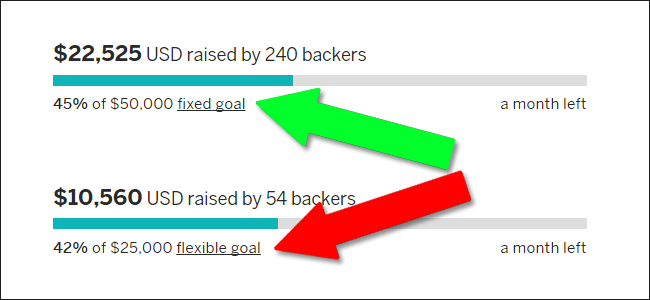Quick Links
Projects on Kickstarter, Indiegogo, and other crowdfunding platforms are mostly on the up-and-up, but there are those just trying to make a quick buck. Here's how you can spot them.
If Something Seems Too Good to be True, It Probably Is
This is pretty good advice for life in general, but it applies to online crowdfunding in particular. If a new gadget seems like it probably can't be achieved with current technology, then it probably can't. This is especially true for the kind of independent teams that seem to flock to Kickstarter for funding.
Now to be sure, some of these "concepts" aren't presented with any kind of malicious intent. They're simply ideas that aren't feasible at the moment. The organizers would know this if they had the engineering or business experience needed to bring a complex hardware product to fruition.
On the other hand, there certainly have been campaigns that fell more on the malicious side---those that were run without any intention of ever reaching completion, banking on potential customers' excitement for a new idea to overcome their common sense. Scams like this have become rarer on Kickstarter since the company began requiring a working prototype for approval. Organizers now need to have at least some kind of technical competence. But these scams still thrive on Indiegogo---the Wild West of crowdfunding---where no such safeguards are in place.
Take, for example, the Skarp---a razor with a laser cutting edge. It's already a bit of a hard sell for anyone too skeptical to believe in a handheld laser tool that's powerful enough to cut hair but safe enough to use on human skin. After the campaign was kicked off Kickstarter for lack of a prototype, the organizers tried their hands at Indiegogo, where it raised over $500,000. A year and a half later the product is still "coming soon" with no verified shipping date, and customers are left with a $300 hole in their wallets. This isn't a verified scam, but it seems less than likely that the product will come to market any time this decade.
Another example is the Smarty Ring, a "smart ring" concept that was little more than a series of renders for a ring that would alert you to new emails and other phone notifications. After two separate Indiegogo campaigns, two years, and nearly half a million in raised revenue, the anonymous organizers disappeared, never delivering anything more than a few half-hearted production photos.
Which brings us to our second point...
Don't Trust Anonymous Campaigns
Kickstarter and Indiegogo campaigns both have profile pages for the people who create them. Investigate those pages thoroughly before you put your money down. Google the people involved, and Google their partners, too. See if their background experience matches the project that they're trying to achieve.
Let's look at a positive example: the Pebble Smartwatch. This wildly successful campaign helped launch an entire product category, but it didn't happen out of the blue. The main organizer, Eric Migicovsky, had already successfully built and sold a series of Bluetooth-connected watches named InPulse. This experience gave him and his team a pedigree in both business and engineering in exactly the field he needed. All this information was readily available online, and was even mentioned in the original Pebble campaign page.
A well-documented crowdfunding campaign should have a real person behind it---with a full name, social profiles that you can verify, and an email address that gets replies (again, with verifiable identities for all concerned). If a campaign has a single name behind it with no links to any kind of verified information, or worse, simply a business name with no history attached, keep your money away from it.
Just Say No to Indiegogo Flexible Funding
Indiegogo's lax standards for verification already make it a target for scammers. But what really pushes it over the edge is its "flexible funding" option. With flexible funding enabled, campaign managers don't actually have to hit their funding goals (which are rather arbitrary in any case) in order to keep the money that backers have pledged. If you back it, they bill your debit or credit card immediately upon the conclusion of the campaign---even if you're the only one who's actually offered them money and they're thousands of dollars away from their goal.
The appeal to organizers is obvious, as is the danger to backers. Without reaching the goal, crowdfunding managers don't have any kind of responsibility to deliver anything they've promised. They can simply pocket the cash and walk away. Sure, some of them might make a token attempt to finish at least some of their goals, but with not even the usual honor code of crowdfunding holding them to it, why would you trust them to do so?
Be especially wary of flexible funding campaigns where the funding goal is exorbitantly high---it doesn't take a million dollars to create a board game. These campaigns might be set to a high goal specifically so that it can't be reached, thus letting the organizer pocket all the money raised without ever offering anything more than a campaign page.
Be Wary of Knockoffs
These days, it's pretty easy to bulk order products from manufacturing hubs like China. And since those products are primarily marketed to larger distributors or retailers, regular consumers might not be aware of them (or of the economies of scale that keep them cheap). Put that together with an eager audience looking for new gadgets, and it's easy for a scammer to pass off an existing product as something new and exciting.
Take LunoWear for example. The campaign raised over $400,000 on Kickstarter for what was implied---but never stated---to be handmade wooden wristwatches. Some of the campaign backers found the same watches being sold on an online Chinese market, sans branding and going for about a quarter of the price. Kickstarter suspended the campaign and never charged backers, after which LunoWear fled to Indiegogo and raised almost the same amount of money for the same watches.
Really, the recurring theme here seems to be to stay the heck away from Indiegogo campaigns. Here are some other general guidelines to use when deciding to back a crowdfunded project:
- Consider waiting: If you can, wait for a campaign to finish and reach the general market before buying. Most of the time, if the product is successful, you'll be able to buy it outright (with no risk) at some point.
- Use a credit card with buyer protection: Some credit cards offer purchase security on payments made with the card, typically allowing you to apply for a reimbursement (and a chargeback to the merchant) within 90 days.
- Curb your enthusiasm: Sometimes even crowdfunded projects that are made with nothing but good intentions fail due to supplier issues, poor planning, or lack of necessary funds.
Above all, use common sense. If something just seems to be off in a crowdfunding campaign, it probably is. Remember your Latin: caveat emptor (let the buyer beware).





